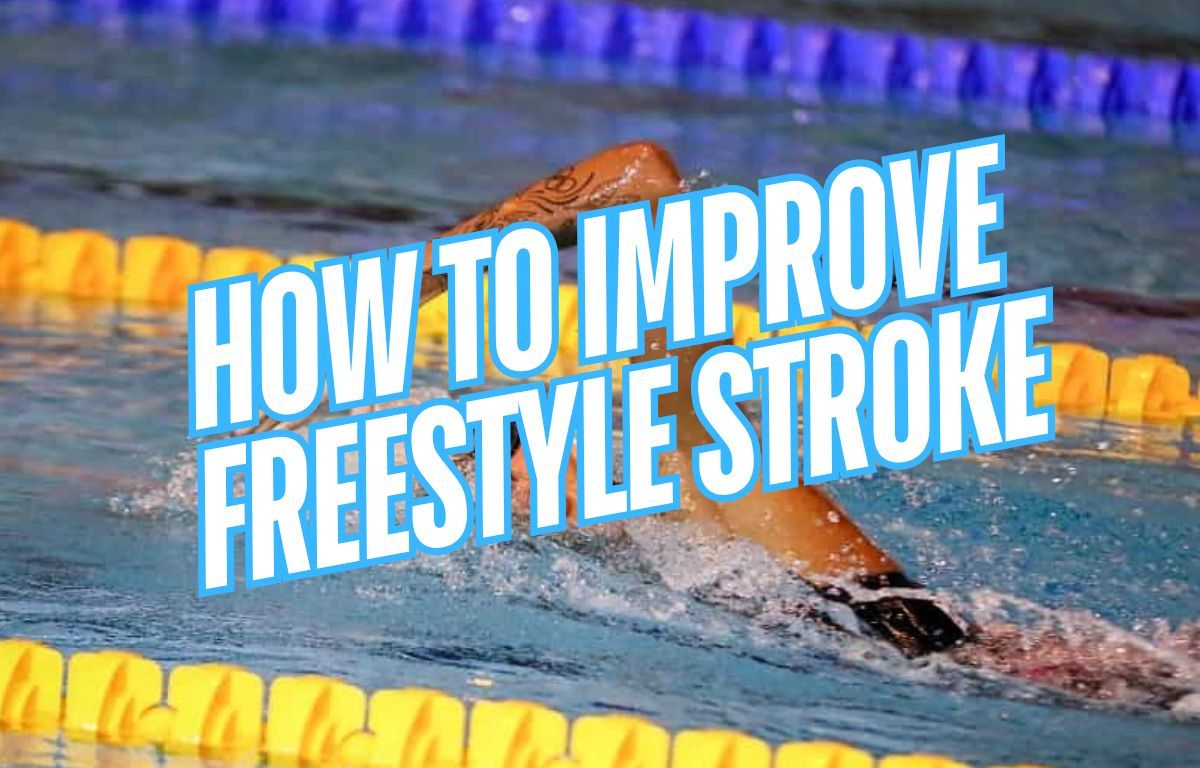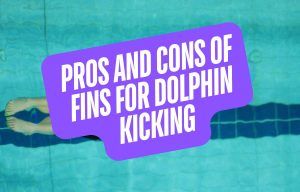Unlock a faster and more efficient freestyle stroke with this list of eight proven tips for killer freestyle technique.
In this guide to swimming with awesome freestyle stroke technique, we will look at every part of improving your freestyle.
Including:
- What position your fingers should be in during the pull
- Why the early vertical forearm is so crucial
- How to know when you are breathing too late
- Why you should focus on swimming “downhill.”
And much more.
There is a lot of advice in this little guide.
Instead of trying to absorb it all (I do love the enthusiasm, however!), tackle 1-2 elements of your freestyle stroke at the pool for a few sessions or a week until that fancy new freestyle stroke becomes more habitual.
Let’s dive in.
How to Improve Freestyle Swim Stroke
Swimmers can improve freestyle stroke by:
- Use proper finger placement
- Improve early vertical forearm
- Proper breathing technique
- Rotate shoulders and hips for increased power
- Focus on swimming “downhill”
- Build a stronger kick
- Swim with intent
- Add resistance
Next, we will look at each tip and strategy and offer advice from some of the best freestylers on the planet, including Olympic champions Nathan Adrian and Caeleb Dressel.
By the end, you will be ready to hit the pool with a faster and more efficient freestyle stroke.
Use proper finger placement
To catch more water with your hand and fingers, swim with your fingers slightly apart.
Researchers in the Netherlands found that a 10-degree spread between fingers increased the overall surface area of the hand. (Thank you, fluid dynamics!) A rough estimate by one of the lead researchers, herself a swimmer, figured a 0.6-second improvement over 50 meters of freestyle.
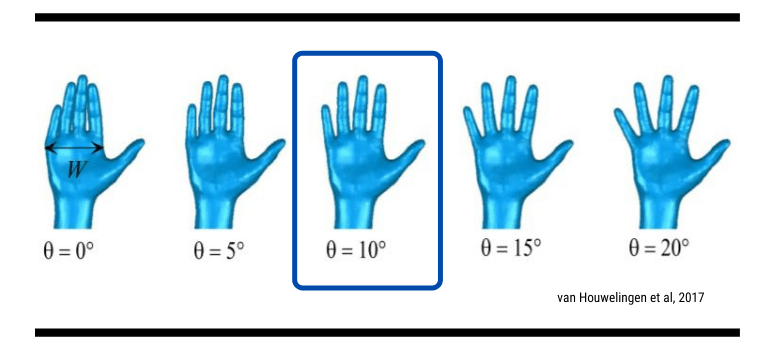
Swimming with your fingers slightly spread is not only more natural, as this is how your fingers generally “rest,” but it also requires less effort compared to flexing your fingers to “cup” the water.
Improve early vertical forearm
The high elbow catch and early vertical forearm set up the pulling motion of your stroke.
You don’t necessarily get a lot of propulsion from this phase of the pulling motion, but an early vertical forearm gets you into the propulsion phase of the pull sooner.
A dropped elbow is the most common error in freestyle. A study of college swimmers at the University of North Carolina found that over 60% had a dropped elbow during the catch.
A dropped elbow means you are getting into the propulsive phase later. It means that you are pushing water down at the front of the pull instead of back, and a dropped elbow is often pre-packaged with other freestyle stroke technique errors, including corkscrew hips, rolling too much to breathe, and more.
When getting into your catch, imagine your hand and forearm rolling over a Swiss ball, “hooking” into the pull.
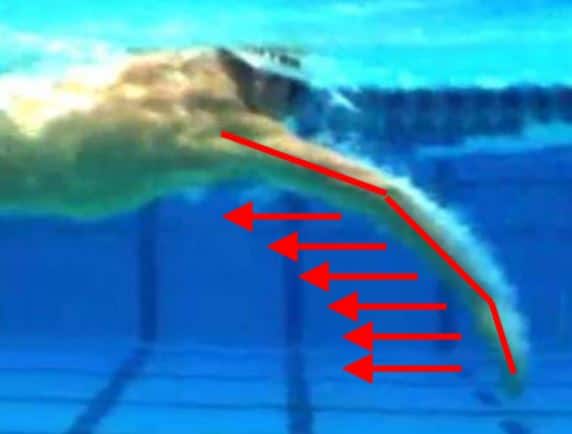
Proper breathing technique
When turning your head to breathe, do it early in the stroke cycle and look squarely at the side wall of the pool.
Swimmers—especially when they get tired—will start swinging their head so that their eyes are looking up into the stands or up to the ceiling.
All of the typical stroke boo-boos subsequently follow: the hips start to slide side to side, ankles cross, and your catch gets soggier than a water-logged cotton towel.
Try keeping one goggle in the water and one out as you breathe. Inhale quickly and return your head to that straight position again.
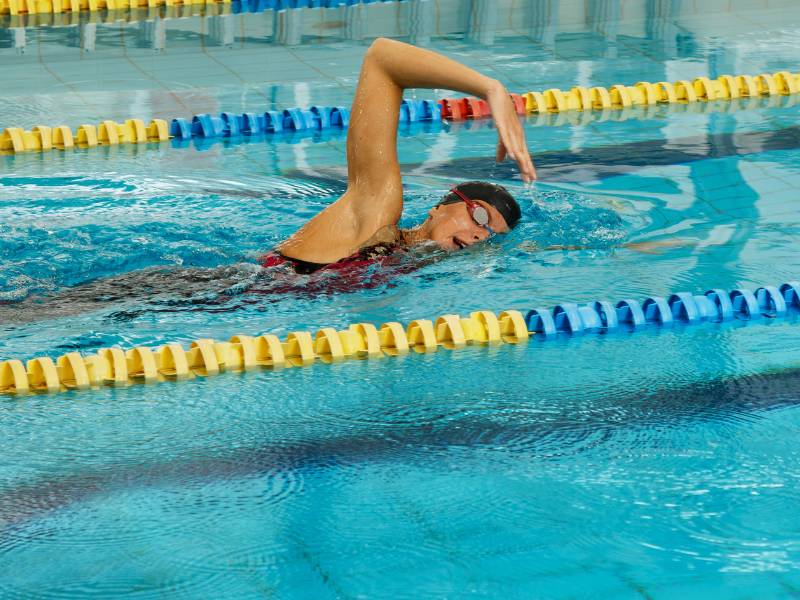
The habit of breathing early in the stroke takes work, but when you get a hang of it, you will find that a lot of errors in your freestyle technique will melt away.
Late breathing (you are still sucking down air when your breathing arm is entering the water) causes over-rotation, a dropped elbow, and cork-screwing hips.
Tip: Exhale slowly under the water instead of releasing your breath all at once. A controlled exhalation helps you manage your breathing patterns.
Rotate shoulders and hips for increased power
With each stroke, you should be reaching and extending with your hand and arm as far as you can reach. Part of the thrust with the hand entry should be created by your hips and core.
A lot of swimmers completely relax their hand entry and the second part of the arm recovery. But this is the perfect opportunity to use your core and hips to drive your hand forward.
Tip: The recovery is a controlled throw of your hand into the next stroke. Think of your shoulders as rotating forward during the recovery.
This coupling motion is a hard one for newbie (and even novice and experienced) swimmers to understand (I still struggle with it from time to time), but once it clicks you will find a reservoir of power and increased distance per stroke that you never knew existed.
“The majority of your rotation is going to come from your belly and your kick. I think to save energy on the arms, you have to gear the rotation more by using your core and your legs.” — Caeleb Dressel, Olympic gold medalist and world champion.
Focus on swimming “downhill”
Body position is critical to fast swimming. When we present a smaller drag profile, we move through the water more easily. One of the quickest ways you can fix poor body position, and reduce excess drag in the water, is to straighten your head position and imagine yourself swimming “downhill.”
Picking the head up to look forward is a completely natural instinct—we are hard-wired to look where we are going, and with unforgiving pool bulkheads and walls coming up fast, we are going to want to see what is ahead.
Tip: Imagine yourself swimming downhill. This will naturally keep your face pointed down and your hips high, reducing drag.
But picking the head up and leading with the forehead means we are snow-lowing the water, creating needless drag. On top of that, picking the head up throws our body position out of whack, causing the hips to sink and create even more drag.
Looking too far ahead is an uncomfortable position for our head and neck to be in, causing our traps a needless amount of tension and fatigue.
Build a stronger kick
A strong kick does more than provide propulsion, though some might argue it’s secondary when improving the freestyle stroke.
In fact, experienced competitive swimmers generate about 29.7-33.4% of force from the kick during tethered efforts (Mourouco et al., 2015).
However, the benefits of a strong kick go beyond propulsion, offering several serious advantages to swimmers trying to get more from their freestyle stroke.
A stronger kick:
- Improves distance per stroke. Kicking helps you drive through the hand entry, giving you a little extra oomph at the top of the stroke.
- Promotes good body position. A strong kick keeps your body position high, particularly when sprinting.
- Provides stability for the pull. Kicking helps you have a stable platform from which you can deliver a crushing pull and recovery.
How to improve your freestyle kick is something that I have covered previously, but here are some quick pointers for championship freestyle kicking.
Kick evenly in both directions (working the “upkick” phase), do some work on a kickboard to get a feel for kicking from your hips (and not your knees), and experiment with swimming with a 2, 4, and 6-beat kick.
Tip: Find that your ankles are constantly banging against each other when you are trying to kick? This is a symptom of over-rotating with your shoulders.
Add resistance
Resisted swimming, which involves adding drag or resistance to your stroke, helps swimmers build more force and become more aware of their body position and technique.
Using tools like swim parachutes, DragSox, or resistance tubing increases this resistance, highlighting the key elements of an efficient freestyle stroke.
One of my favorite sets to do with swimmers is using light resistance at the beginning of a big swim workout to engage the right muscle groups for an efficient freestyle stroke.
A study published in the Journal of Sports Biomechanics with competitive swimmers found that 11 weeks of regular training with a swim parachute increased swimming velocity and stroke rate. Swimmers also improved “propulsive continuity,” meaning they spent more time in the propulsive phases of the freestyle stroke.
Light resistance encourages swimmers to “self-organize” the stroke and use better technique to overcome resistance.
The elbow in the catch gets a little higher. The core gets a little more engaged. The streamline tightens when pushing off. The head position aligns in a more neutral position.
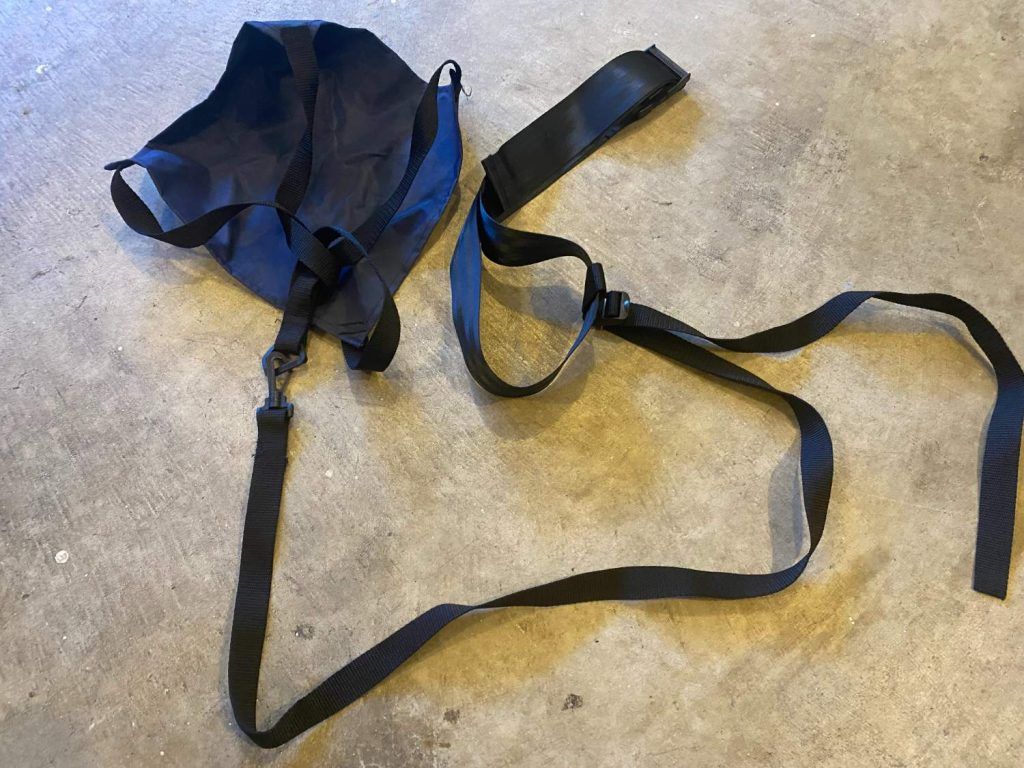
Add some light resistance between warm-up and the main set to help sharpen technique and “prime” better freestyle stroke technique.
For example:
8×25 freestyle with light swim parachute – Take 30s rest. Perform each repetition at 60% effort, focusing on the increased awareness of a better stroke.
While resistance tools in the water are typically used to improve force and speed, they are also an excellent way to improve your freestyle stroke.
The best parachute for swimmers is the FINIS Swim Parachute (pictured above).
It’s made with highly durable nylon, has an adjustable belt for a secure fit, and multiple chute sizes for variable resistance.
Use the light chute for technique and stroke work, and when you are ready to crank up the power in your freestyle stroke, progress to wider chutes.
Note: Save 20% at FINIS with discount code LANE6
Swim with intent
Improving your freestyle stroke technique isn’t easy. It requires deliberate concentration.
Thinking about your hand placement, hip roll, kicking consistently, that high elbow on the catch, not swinging your hips during the recovery, and on and on.
Concentrating on all this stuff is not easy. After all, swimming is not a natural movement to us land-dwellers.
Swimming slowly and with the best technique you can muster is mentally taxing, deliberate practice at its finest.
Tip: When trying to master a new part of your freestyle stroke, slow things down. Wear fins and a snorkel if necessary so that you can deliver all your focus on technical excellence.
When doing drills to improve his freestyle (his favorite is single-arm freestyle, in case you were wondering), Olympic champion Nathan Adrian, who took the gold in the 100-meter freestyle at the London Olympics, has this piece of advice for swimmers who are looking to improve their stroke with drills:
“Go slow and take plenty of rest. Nothing bothers me more than coaches that put in new or really difficult drills on tough intervals,” says Adrian. “There is a time and place for that. It is not, however, when trying to perfect a new skill.
More Resources on How to Improve Your Freestyle
Here are some more resources and guides that I have put together over the years on how you can improve your freestyle technique.
How Training with a Six-Beat Kick Will Improve Your Freestyle. How much of your swimming is done with a six-beat kick? Here are some of the cool things that happen when you kick like a champion.
Super Slow Swimming: How to Improve Your Technique and Feel for the Water. Swimming slowly and deliberately can make you a faster, more efficient swimmer.
10 Freestyle Drills for Better Technique. Power up your freestyle with ten drills from some of the best coaches and swimmers on the planet.
How to Develop an Unstoppable Freestyle Kick. The top athletes in the pool are not only fast swimmers, they are fast kickers. Here is your guide to a faster freestyle kick.

